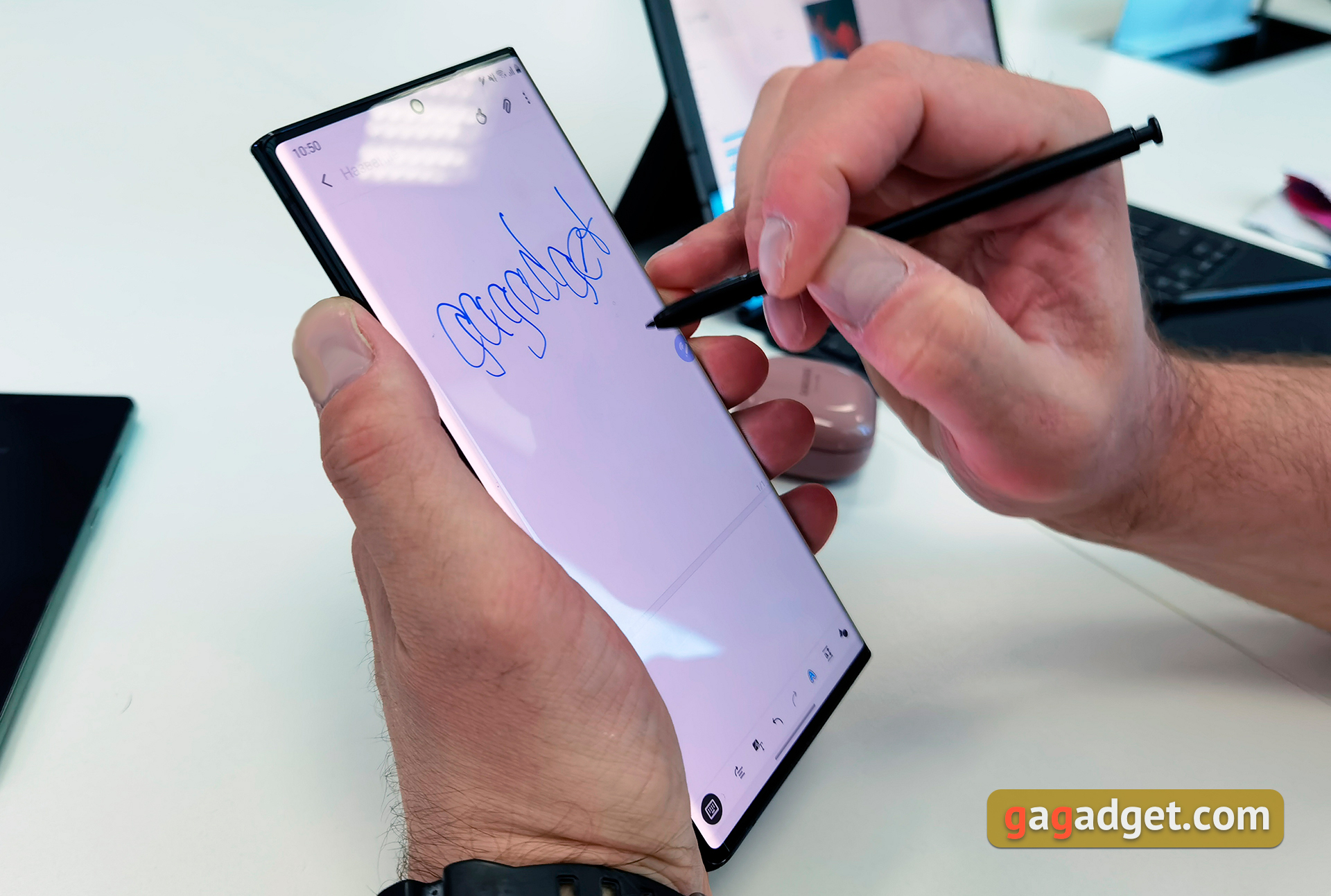
</ img>
Samsung annually presents its flagship Note series smartphones at a separate event in August.
What's new in Samsung Galaxy Note20 and Note20 Ultra?

</ img>
As last year, the company immediately releasedtwo models: Samsung Galaxy Note20 and Note20 Ultra. They are aimed at different audiences and differ not only in size. Samsung Galaxy Note20 Ultra - “top” with the maximum stuffing that Samsung has at the moment. Samsung Galaxy Note20 is more “compromise” and, accordingly, a more affordable option. In short, the important differences are the different screens. Ultra is curved on the sides with a resolution of 3200×1440 and a refresh rate of 120 Hz, though only FullHD+, as in the flagship S20 line. The set of cameras, battery capacity, RAM and internal memory configurations differ. And the dimensions, of course. At the same time, the same processor is used: Exynos 990.
Specifications
Samsung Galaxy Note20
Samsung Galaxy Note20 Ultra
Display
Super AMOLED+, 6.7 inches, 2400×1080 (20:9 aspect ratio), 393 ppi, HDR10+, 60 Hz, Gorilla Glass Victus
Side-curved Dynamic AMOLED 2x, 6.9 inches, 3200×1440 (20:9 aspect ratio), 508 ppi, HDR10+, 120 Hz @ FullHD+, Gorilla Glass Victus
Housing
Dimensions: 161.6×75.2×8.3 mm
dimensions: 164.8×77.2×8.1 mm
CPU
64-bit 7nm Samsung Exynos 990, 2xExynos M5, 2.73 GHz, 2xARM Cortex-A76 2.5 GHz, 4xARM Cortex-A55 2.95 GHz, Neural Processing Unit (NPU), ARM Mali-G77 MP11 graphics
64-bit 7nm Samsung Exynos 990, 2xExynos M5, 2.73 GHz, 2xARM Cortex-A76 2.5 GHz, 4xARM Cortex-A55 2.95 GHz, Neural Processing Unit (NPU), ARM Mali-G77 MP11 graphics
RAM
8 GB
12 GB
Flash memory
256 GB UFS 3.1
256/512 GB UFS 3.1, MicroSD
Camera
12 MP (f/1.8, 26 mm EGF, 1/1.76″, 1.8 µm, Dual Pixel PDAF) + 64 MP telephoto (f/2.0, 1/1.78″, 0.8 µm, PDAF), optical stabilization, 3x zoom, ultra-wide-angle 12 MP, f/2.2, PDAF; flash, video 8K@24fps, 2160p@60fps, 1080p@240fps, 720p@960fps; front camera: 10 MP f/2.2 with autofocus
108 MP (f/1.8, 26 mm EGF, 1/1.33″, 0.8 µm, Dual Pixel PDAF, OIS) + 48 MP periscopic telephoto (f/3.5, 103 mm EGF, 1/2.0″, 0.2 µm, PDAF, OIS, 5x) + 12 MP ultra-wide-angle, (f/2.2, 13 mm EGF, 1.4µm), video 4320p@24fps, 2160p@30/60fps, 1080p@30/60/240fps, 720p@960fps; front camera: 10 MP f/2.2 with autofocus
Wireless technology
Wi-Fi 802.11 b/g/n/ac/ax (dual band, 2.4 and 5 GHz), Bluetooth 5.0 LE, NFC, ANT+, UWB
Wi-Fi 802.11 b/g/n/ac/ax (dual band, 2.4 and 5 GHz), Bluetooth 5.0 LE, NFC, ANT+, UWB
GPS
GPS, A-GPS, GLONASS, BDS, GALILEO
GPS, A-GPS, GLONASS, BDS, GALILEO
Battery
4300 mAh, non-removable, 25W fast charging, 15W wireless charging, reverse wireless charging
4500 mAh, non-removable, 25 W fast charging, 15 W wireless charging, reverse wireless charging
operating system
Android 10 + One UI 2.5
Android 10 + One UI 2.5
Sim card
2xNanoSIM
2xNanoSIM
Additionally
IP68 dust and water resistance, ultrasonic in-screen fingerprint scanner, Samsung Wireless DeX
IP68 dust and water resistance, ultrasonic in-screen fingerprint scanner, Samsung Wireless DeX
Externally, the Note line always looks more“strictly” than S. This tradition continued this year. Samsung Galaxy Note20, Note20 Ultra received “chopped” the top and bottom edges, due to which they look a little more “angular”. Both models will be available in several color options. We decided to abandon gradient colors this year. At the same time, the rear glass, depending on the color option, can be either glossy or matte. Matte options look and feel very nice. But there are also nuances: Samsung Note20 Ultra will only be matte bronze. Black and white options are glossy. And the top configuration is only black. Galaxy Note20 will be matte “enhanced” polycarbonate back.
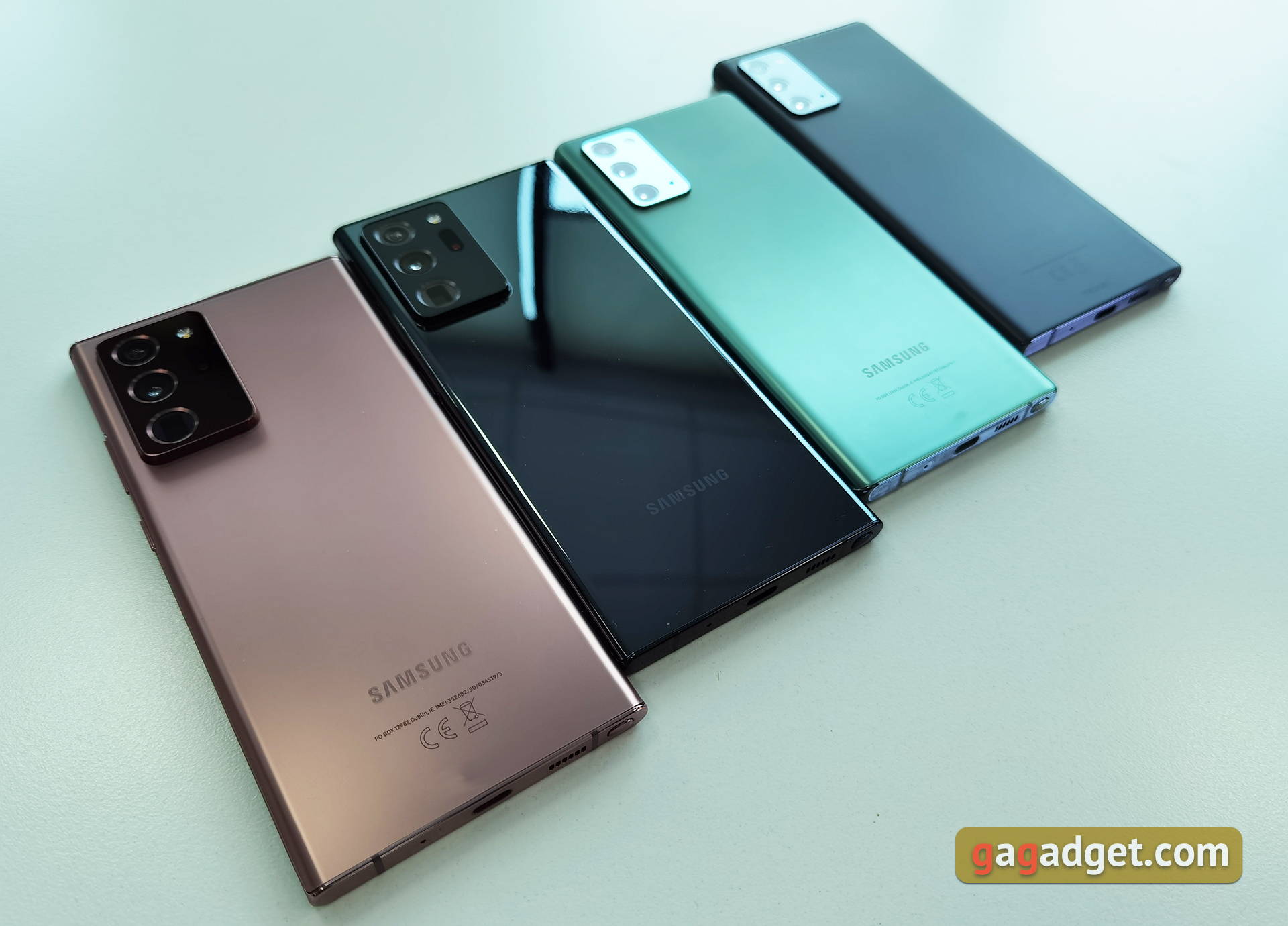
</ img>
The Ultra model is equipped with 6 curved sides.9-inch Dynamic AMOLED 2x display with a resolution of 3200 x 1440 and a refresh rate of 120 Hz (at FullHD+ resolution). Galaxy Note20 has a flat 6.7-inch Super AMOLED+ with FullHD+ resolution. I am sure that the option without bends will appeal to an impressive number of users. The only unpleasant thing about the Galaxy Note20's screen is 60 Hz. Having used 90 and 120 Hz screens, switching back to 60 is extremely difficult. The front cameras are still made in the form of a hole, but it is claimed that it has become smaller.

</ img>
By the arrangement of functional elements everythingalmost as usual. The buttons on the right, on top are the tray and microphone. There is no 3.5 mm jack, only Type-C, there is also an external speaker and microphone on the bottom. The case is protected against dust and water according to the IP68 standard. The location of the S Pen has changed. Last year, the stylus was placed closer to the right edge of the smartphone. This year - closer to the left. Apparently, the dimensions and design remained the same.
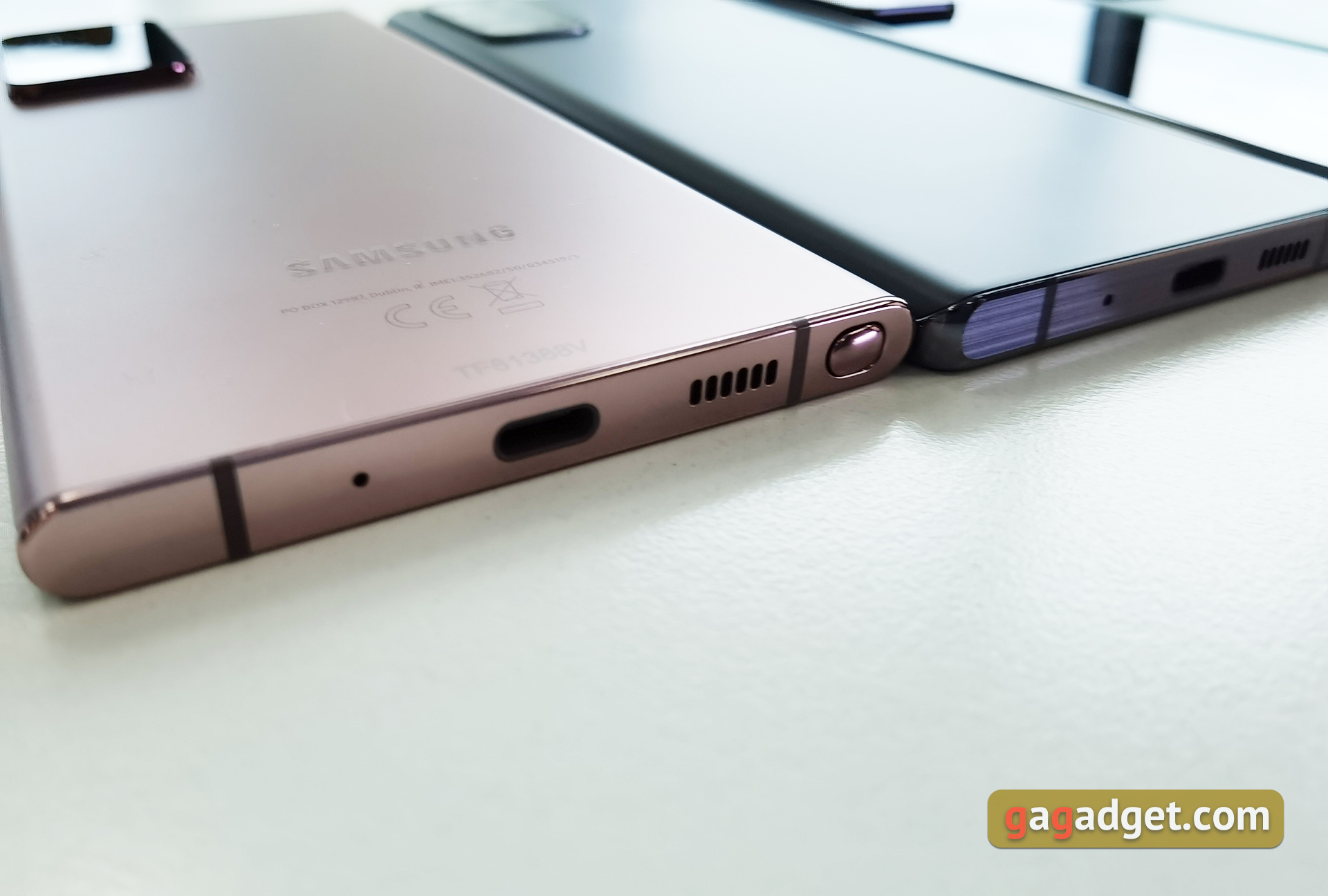
</ img>

</ img>

</ img>



Although there were some innovations.The S Pen is equipped with Bluetooth LE, a gyroscope and an accelerometer, and supports operation as a remote control and air gestures. It can recognize 4096 degrees of pressure and detect inclination. The company has significantly reduced the response time when drawing/texting using the S Pen: now the older model has 9 ms, the younger model 28 ms. In the previous generation it was 40+ ms, if I'm not mistaken. From personal observations, the tip is slightly spring-loaded, making touches to the screen feel soft and really more reminiscent of a traditional pen and notepad. Auto-recognition of handwritten text has become more accurate (again, based on personal feelings).

</ img>

</ img>

</ img>



We already mentioned the back panel, nowLet's focus on the cameras. On the Galaxy Note20 and Note20 Ultra, the main cameras are made in the form of large rectangular blocks, in which the cameras themselves are placed vertically. On the Note20 Ultra, this block sticks out very noticeably. Which is not surprising: it uses a configuration similar to the Galaxy S20 Ultra with a huge 108 MP module and a periscope camera that provides 5x optical zoom. The Galaxy Note20 has a much smaller camera protrusion, and the configuration is the same as the Galaxy S20+. The numbers for the cameras are in the table above, and we will look at the camera capabilities in more detail in the reviews. In its new products, the company focused on video capabilities. There is the possibility of video recording up to 8K@24p. Among the important features, it is worth mentioning the smooth operation of the zoom (without jerking, as we are used to seeing when switching between different modules) and an advanced sound recording system. The smartphone has 3 built-in microphones, and you can also use external wired and wireless models. You can switch the directionality of the built-in microphones and sources directly during video recording.




According to Samsung, recentlyNowadays, the company focuses on the ease of use of its smartphones and does not chase the numbers in its smartphones, in particular, the scores in benchmarks. This is only partly true: the Note20 line for the US is equipped with Qualcomm Snapdragon 865+ and, I believe, will still be at the top in benchmarks. The international version uses the flagship Exynos 990 processor, already well known from the Galaxy S20 line. Yes, it is inferior in performance to the flagship Snapdragon, but its power reserve is more than enough for current applications and games. For those interested, here are a couple of screenshots with benchmarks. It is noteworthy that the throttling test was launched immediately after AnTuTu. Despite this, there are no problems with overheating:




</ img>




Wireless interfaces have the whole set,including Wi-Fi 6. And even more: the rumors were confirmed, smartphones received UWB (Ultra Wideband) support. The specifications of this standard were approved back in 2018. In short, this is a wireless ultra-wideband data transmission technology that has a high data transfer rate, can locally determine the location of objects with an accuracy of 2 cm (indoors in particular) and has extremely low power consumption. Of the possible areas of application, the most obvious is IoT: automation and management of the “smart” houses, access turnstiles and so on. Plus fast data transfer between devices - up to 480 Mbit/s. But there is one important feature: the data transfer speed drops very noticeably with even a slight increase in distance. Another feature that was heralded in rumors and leaks is Wireless DeX. This is the desktop mode already familiar from previous flagships, but now with support for wireless connections. You can connect to any TV/monitor that supports Miracast. And as manipulators, use either a keyboard and mouse, or the screen as a touchpad.

</ img>

</ img>


Samsung Galaxy Note20, Note20 Ultra receivedbatteries for 4300 and 4500 mAh, respectively. Fast wired and wireless charging are supported, as well as reverse wireless charging for accessories.
Samsung Galaxy Tab S7 and Tab S7 +

</ img>

</ img>

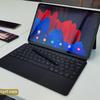
This year Samsung decided to release twoflagship tablet. The main difference between them is the diagonal and display type. Outwardly, the only noticeable difference is the size difference. Both tablets received a similar design: a thin metal body with “chopped” edges and rather thin frames around the perimeter of the screen. The Galaxy Tab S7 model is equipped with an 11-inch display with a resolution of 2560x1600 pixels, most likely using its own PLS matrix. The top version of the Galaxy Tab S7+ has a 12.4-inch Super AMOLED screen with a resolution of 2800x1752. Both variants support a 120Hz refresh rate and HDR10+ standard. Visually, the screens are gorgeous, especially for the older model.
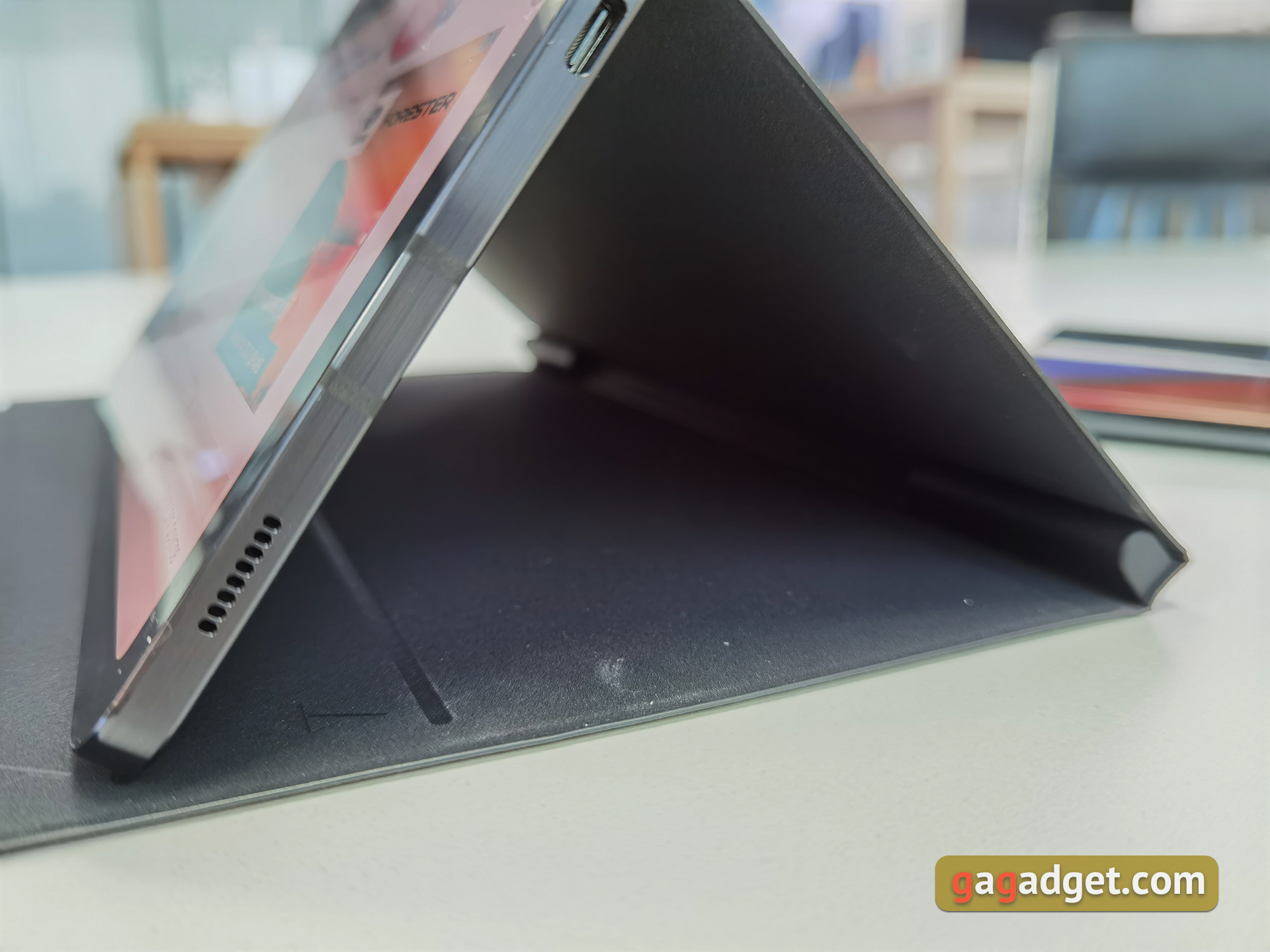
</ img>

</ img>

</ img>



To unlock in the younger model, useFingerprint scanner in the power button on the side panel. The older model has face recognition. The front camera is used for this; there are no additional sensors. Both models support the S Pen stylus and, apparently, it will be included. Charging will occur wirelessly when the stylus is “attached” to the tablet, for this there is a corresponding place on the back next to the dual main camera. The S Pen is the same size, weight, and feel as a standard pen. The tip is made similarly to the Galaxy Note20 and Galaxy Note20 Ultra, that is, it does not hit the screen, but creates the effect of a softer touch, like on paper.

</ img>
Inside, the tablets have identical and very interesting hardware. Both versions received the flagship Qualcomm Snapdragon 865+ processor, 6 GB of RAM and 128 GB of internal storage plus a MicroSD slot.





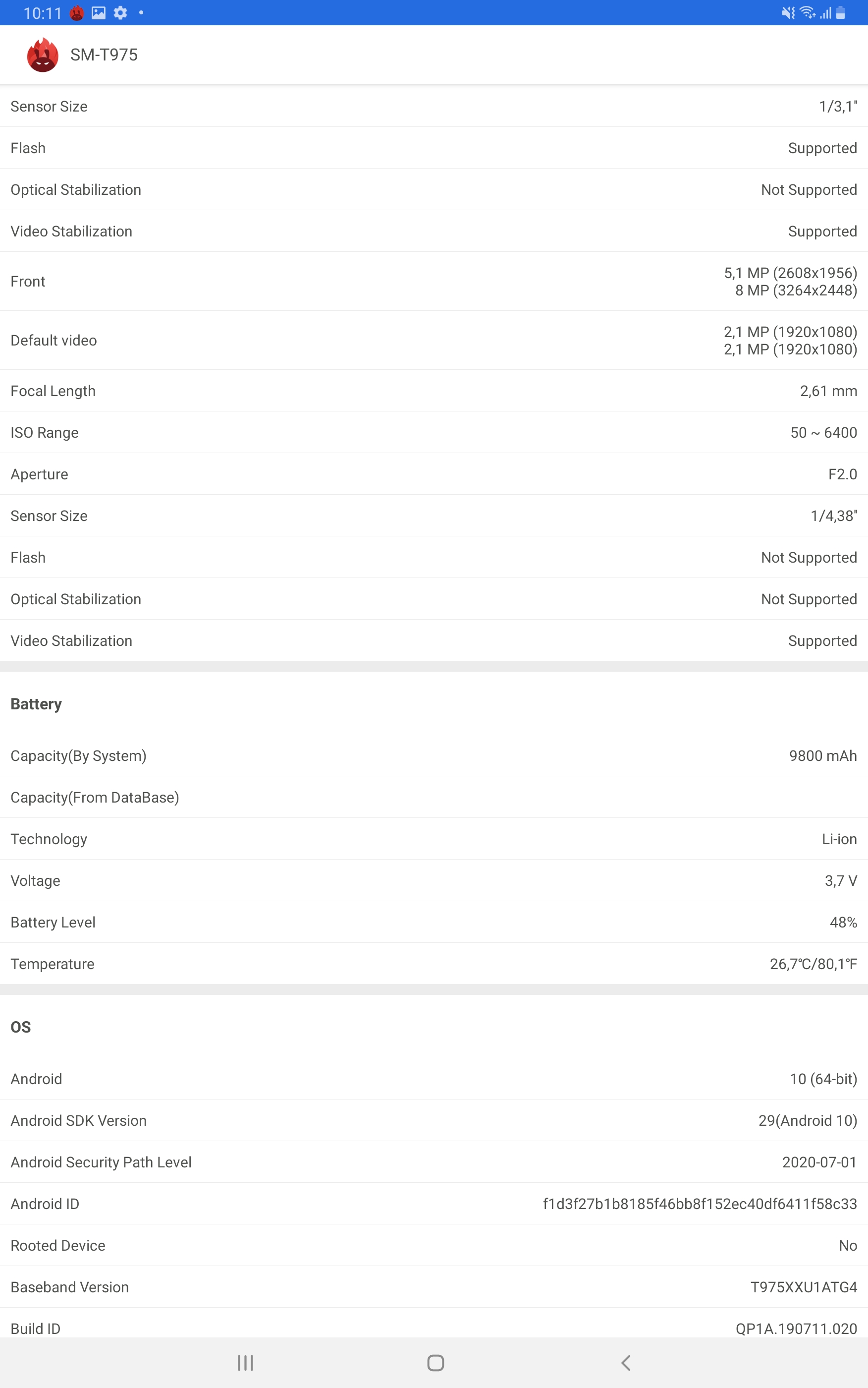






There is also space for a SIM card: tablets support mobile networks. The suite of wireless interfaces includes dual-band Wi-Fi 6, Bluetooth 5.1 and GPS. Wireless DeX is also supported. But, unlike smartphones from the Galaxy Note20 line, you do not need to connect to an external monitor to use the desktop mode. An optional keyboard cover will be available, with the help of which the tablet (especially the larger model) turns into something as close as possible to ultrabooks. The keyboard has a familiar layout and a quite comfortable touchpad. Wanguyu that by pre-order this keyboard can be received as a gift.
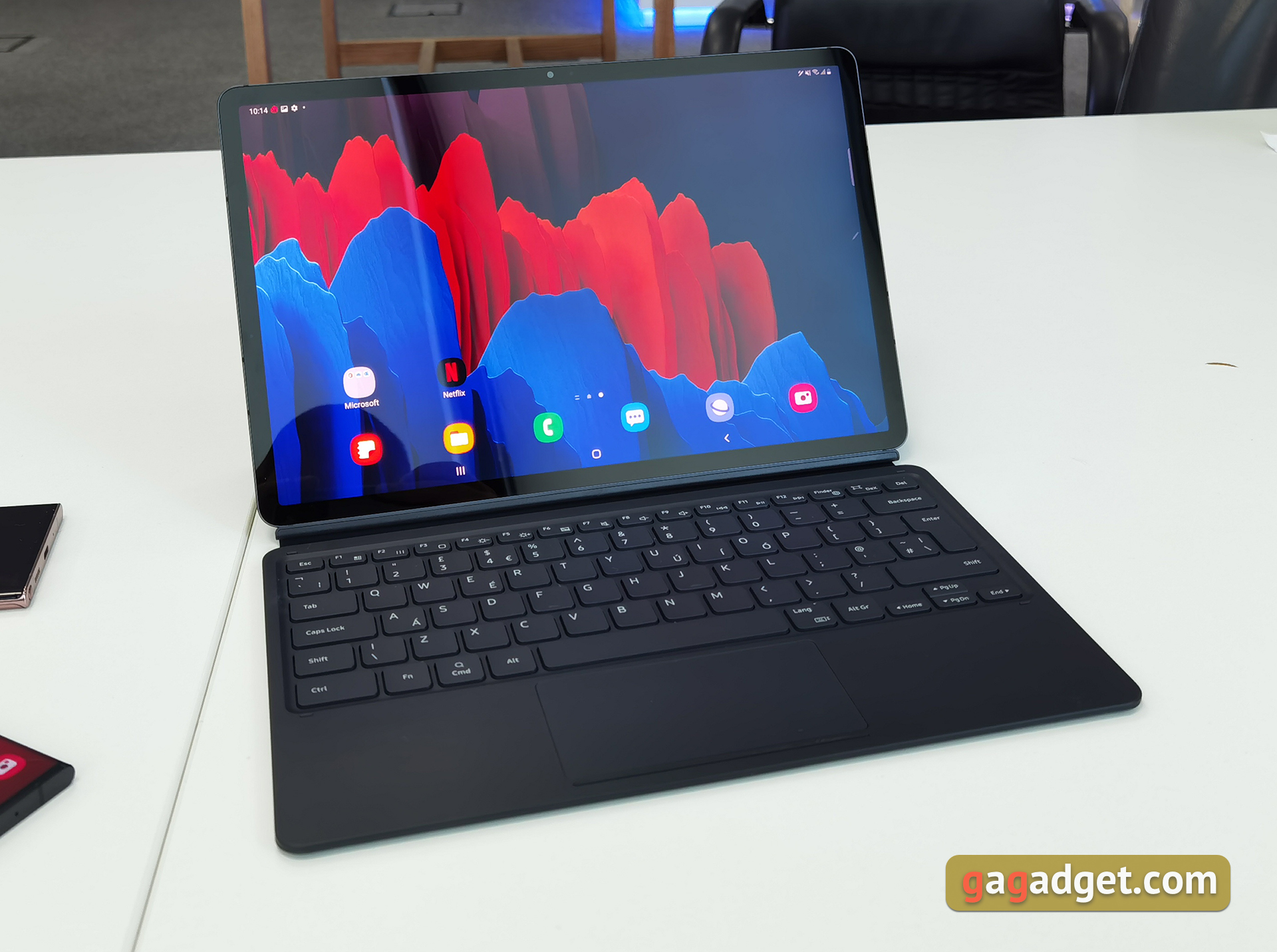
</ img>
An audio system of four is responsible for the sound.AKG speakers. The main camera consists of two modules: a 13-megapixel main one and a 5-megapixel ultra-wide-angle one. Front camera - 8 MP. The regular Samsung Galaxy Tab S7 model is equipped with a 7040 mAh battery, while the older model has a 10090 mAh battery. Fast charging with a power of 45 W is supported, but the traditionally corresponding power supply will not be included in the package.
Samsung Galaxy Watch 3
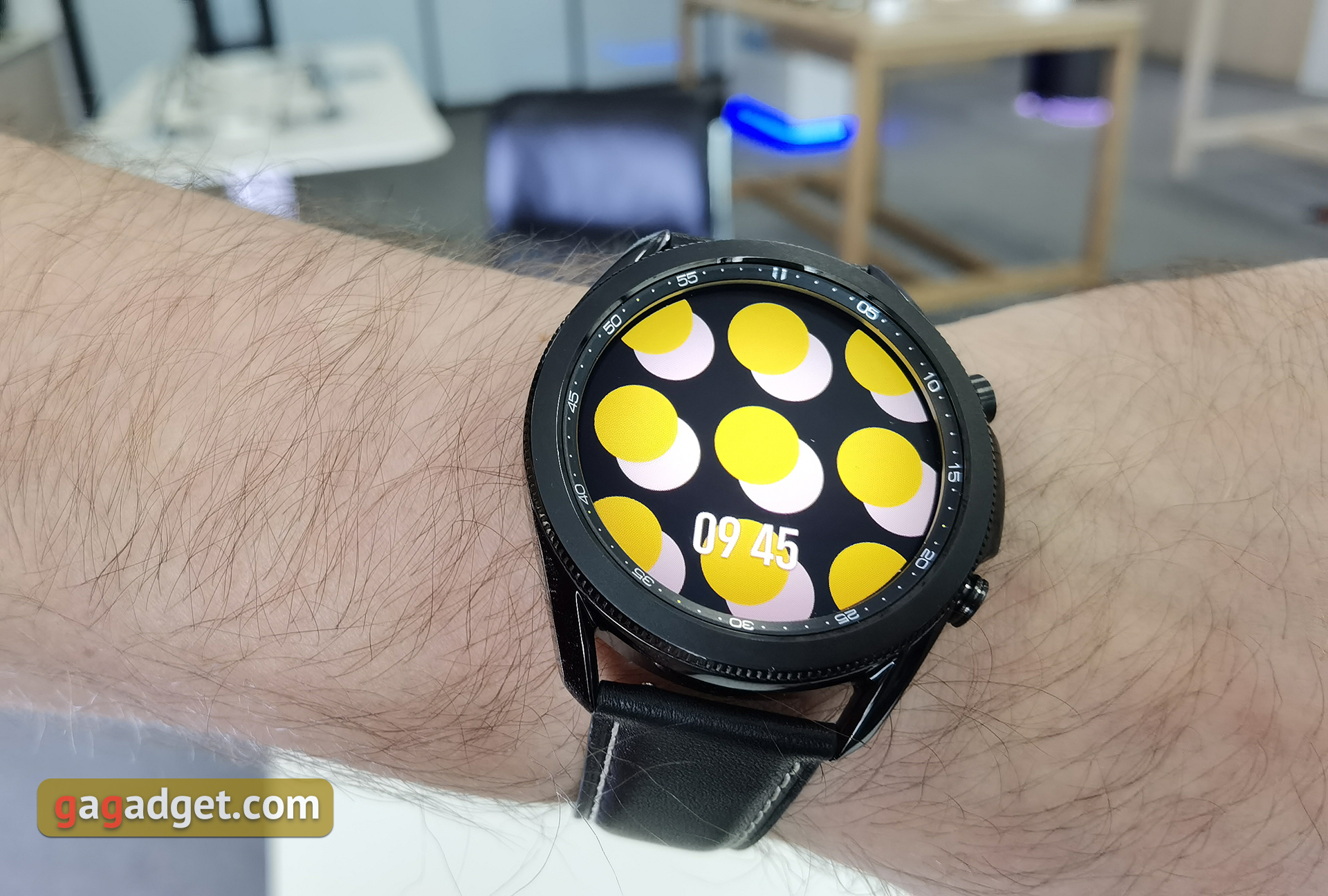
</ img>
Smart watches Samsung Galaxy Watch 3 have already receivedfamiliar construction and design, although there are some changes. The watch will be available in two sizes, the case is metal, and there is a rotating bezel. It is worth saying about it that in the larger model it has small teeth along the perimeter. Less - without. Personally, the bezel itself has become more pleasant. It's difficult to explain tactile sensations. More elastic and informative, probably. In terms of dimensions, the models remained approximately the same as their predecessors, but the screens became slightly larger: 1.2 and 1.4 inches, respectively. These are round SuperAMOLED matrices with a resolution of 360x360.

</ img>
According to Samsung, thefitness functions of the watch: there are significantly more preset training options, pumped up auto-recognition of activity. The accuracy of the heart rate monitor, sleep quality tracking and stress score has increased. The functions of measuring the level of blood oxygen saturation, pressure and, in theory, an ECG have appeared. Why in theory? Technically, there is such a possibility, but for its operation, certification in the Ministry of Health is required, which somewhat complicates this process. An interesting innovation is the function of determining the asymmetry when running (for those who are learning to run correctly). And also the ability to connect for hours to a TV and run video instructions for exercises on it.
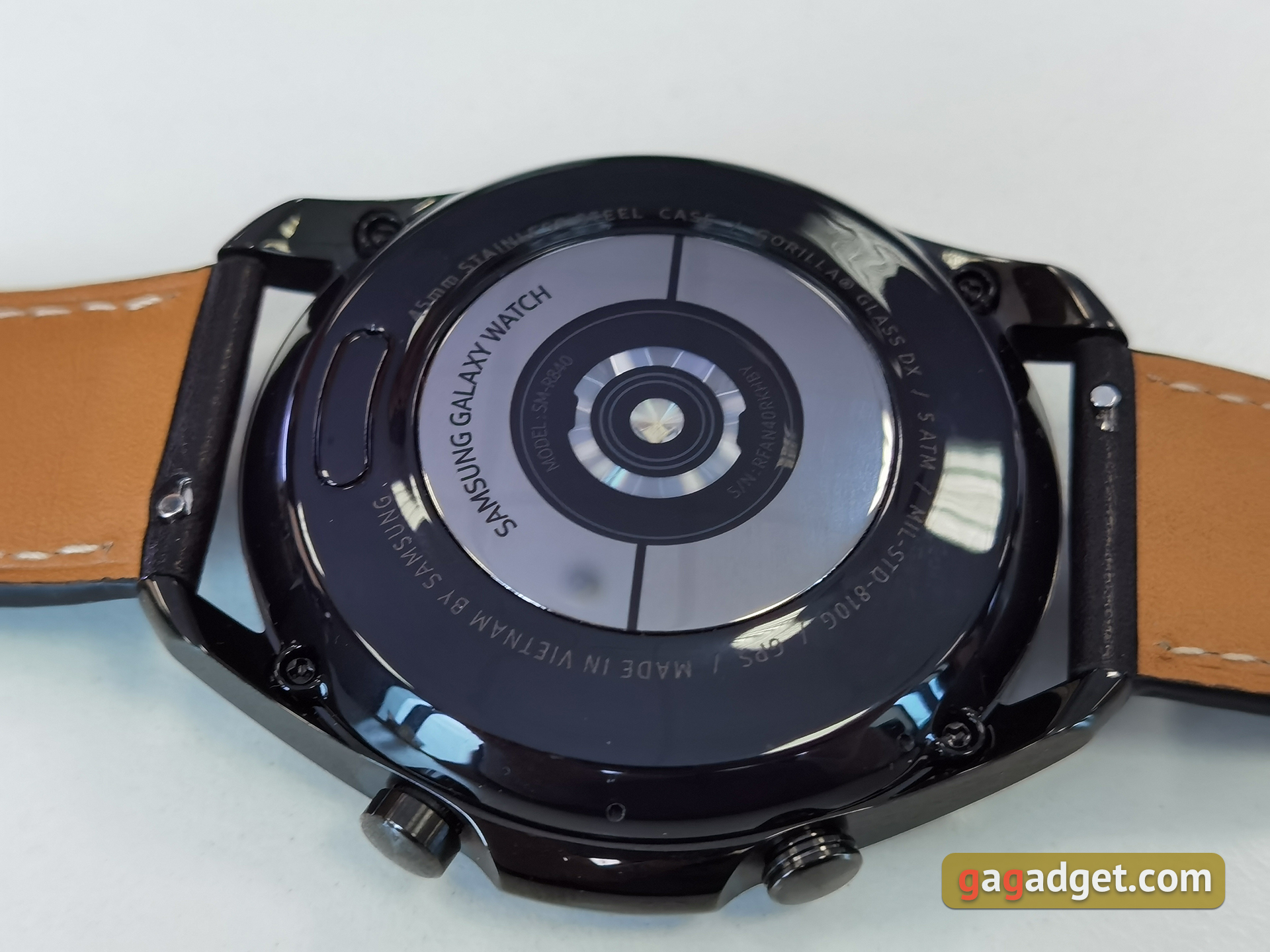
</ img>
The clock is powered by the Exynos 9110 processor, 1GB of RAM and 8 GB of internal memory. You can upload music to it and use the Galaxy Watch 3 as a player. The device runs the updated TizenOS 5.5 operating system. There is Wi-Fi, Bluetooth and NFC. Interestingly, Samsung plans to launch contactless payment here using the Galaxy Watch 3, but there is no information on timing and implementation yet. It probably won't be Samsung Pay, but some third-party local solution. The models are equipped with batteries with a capacity of 247 and 340 mAh, respectively; we’ll see how long this will last in real life. Of course, there is protection from dust and water; the watch can withstand up to 5 ATM.

</ img>
Samsung Galaxy Buds Live
Galaxy Buds Live truly wireless headphonesare significantly different from previous Galaxy Buds models, both in form and design, as well as functionality. They received an active noise reduction system, which was not previously in the line. There is also an AOM (Always On Mic) function for communicating with a voice assistant. The headphones visually really do look like large beans: the renderings that leaked online were true. The colors are matched to the current Note20 Ultra. Each earphone is equipped with three microphones, and 12 mm dynamic drivers are responsible for the sound. Sound tuning has traditionally been handled by AKG. We'll find out how successful it is when the headphones arrive for review.
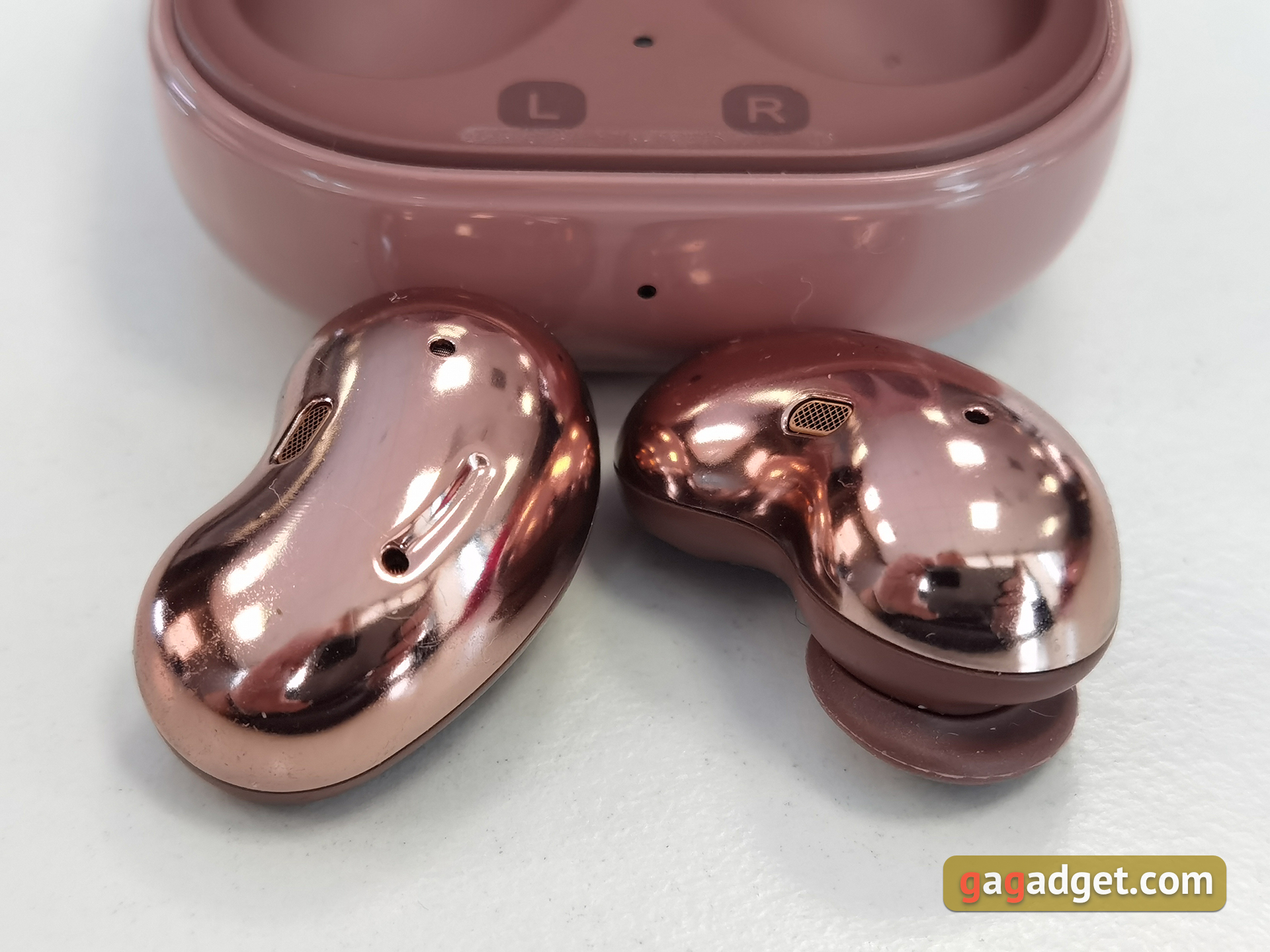
</ img>
On the internal parts of the headphones, contacts forchargers, around which there are special additional latches that will help the Samsung Galaxy Buds Live not fall out of your ears. They are replaceable and come in different sizes. As it turned out, the design is really comfortable; the headphones do not try to fly out of the ear. The headphones support touch control and various noise reduction settings.

</ img>
The operating time on a single charge is promised to be at level 7.5 hours without active noise reduction, with noise reduction – up to 5.5 hours. The charging case will provide up to 28 hours of use. It can be charged either via a Type-C cable or wireless charging.

</ img>
All new items will be on sale towards the end of August. And in the near future their reviews will appear on our website. Prices in Ukraine:
- Samsung Galaxy Note20 Ultra 5G (512 GB):41,999 UAH
- Samsung Galaxy Note20 Ultra (256 GB):35,999 UAH
- Samsung Galaxy Note20:28,999 UAH